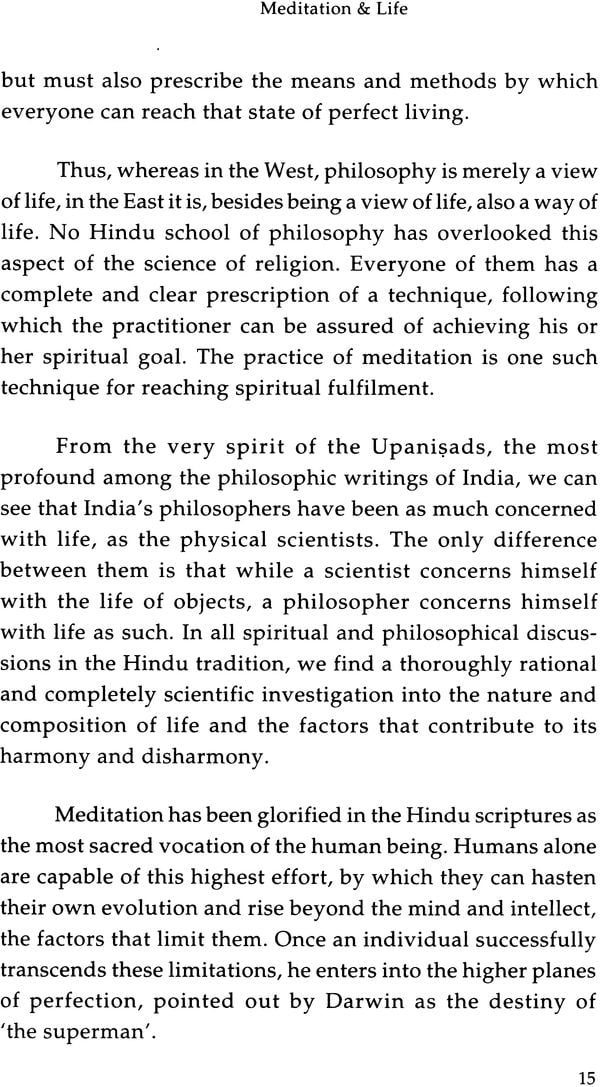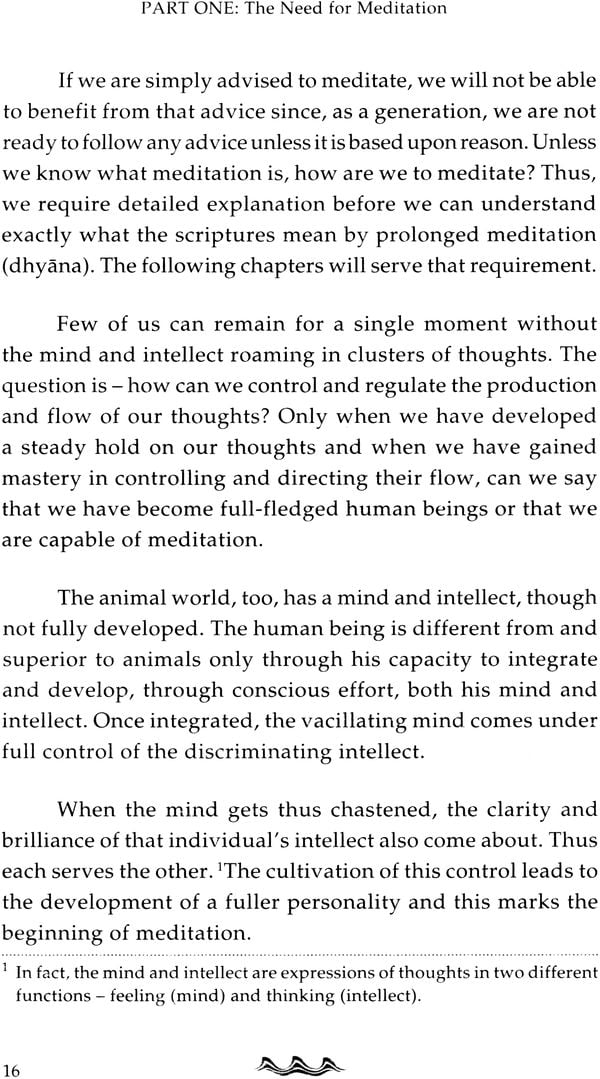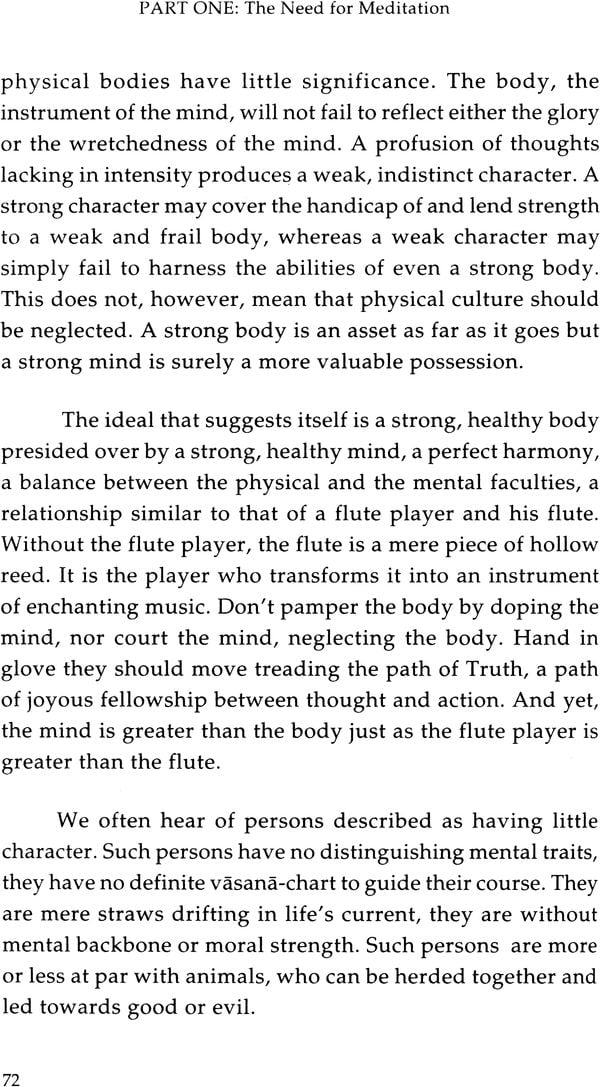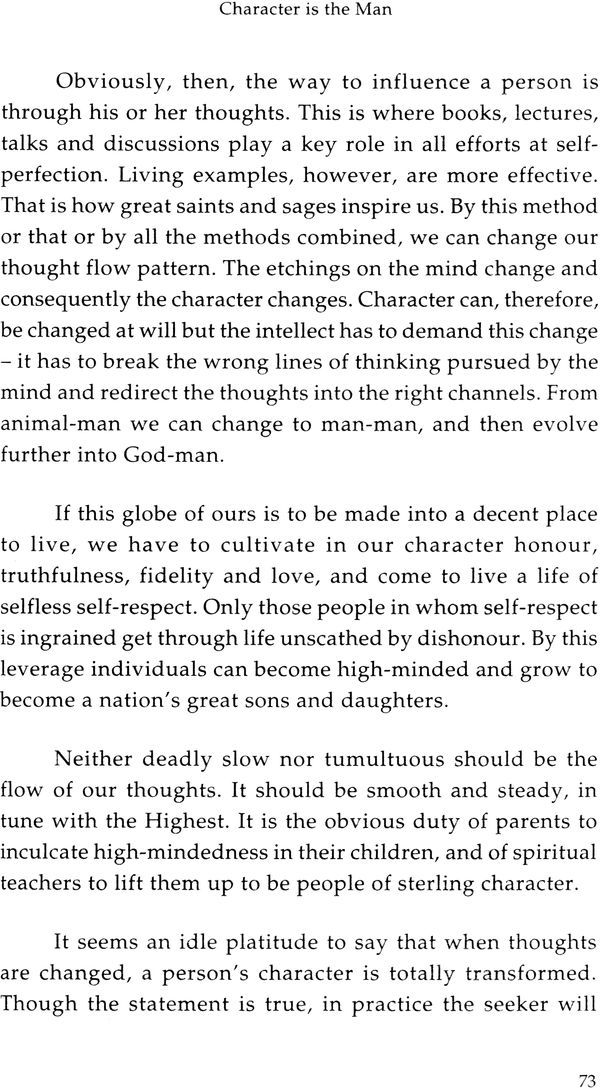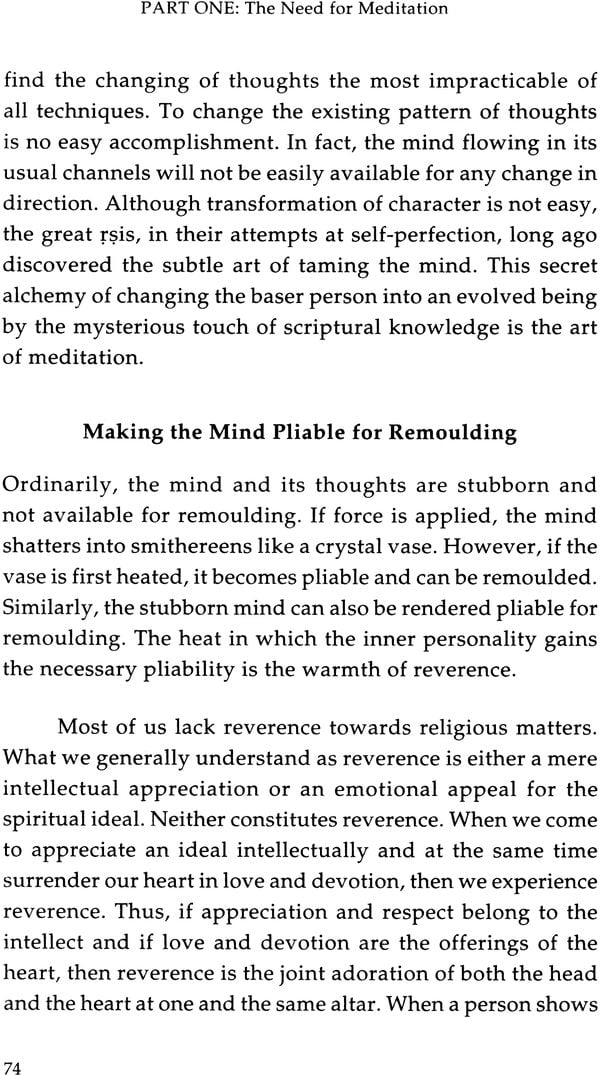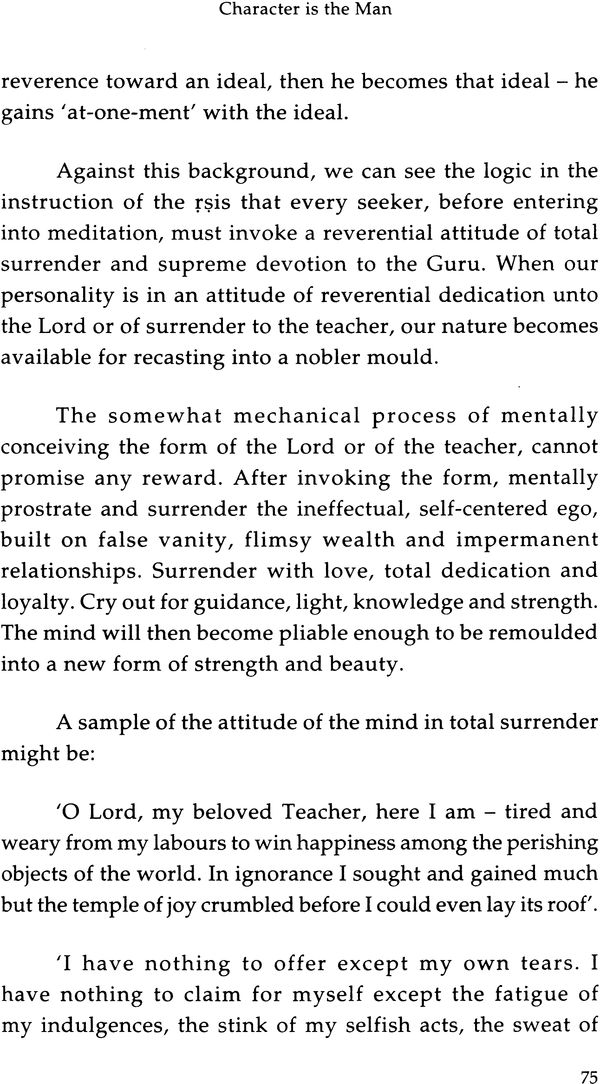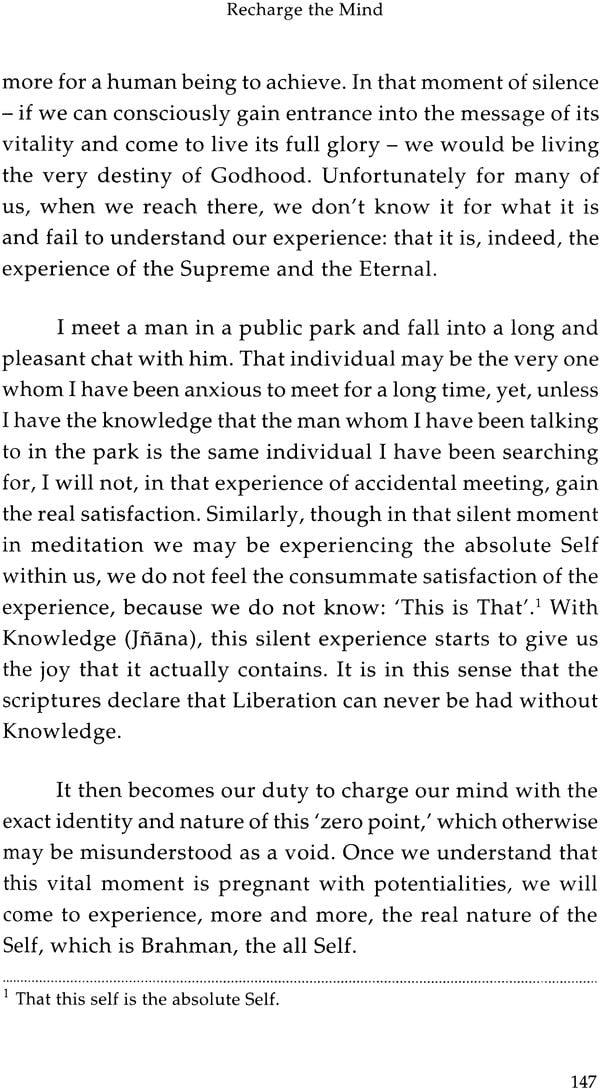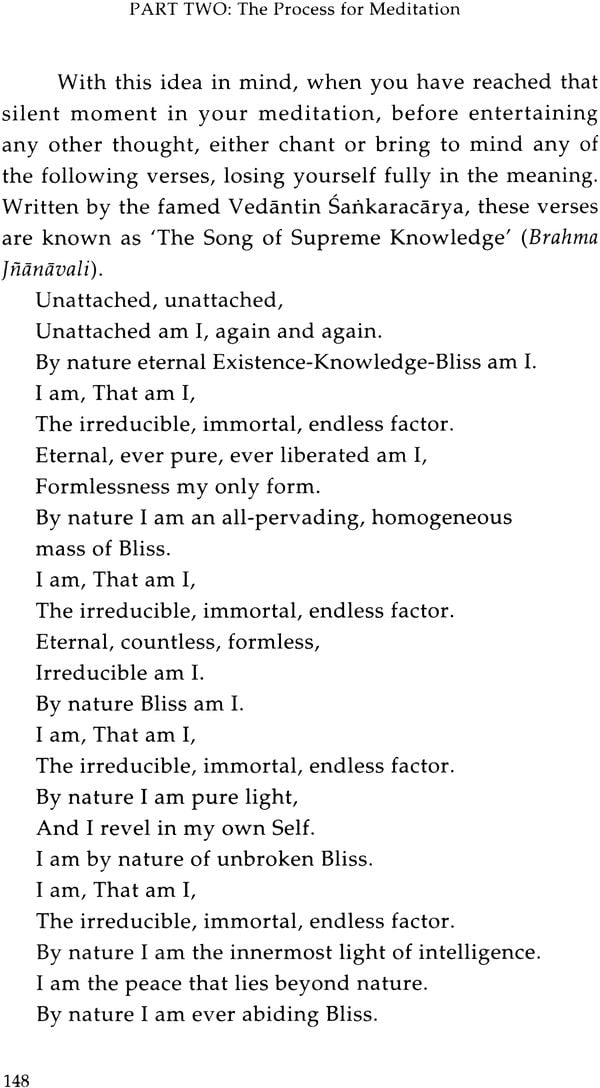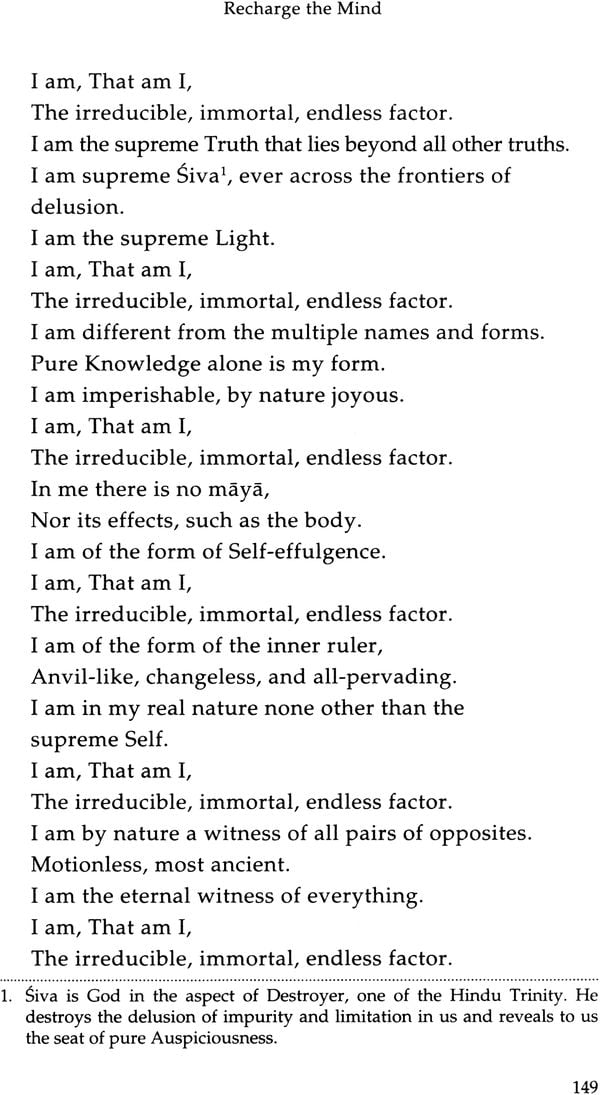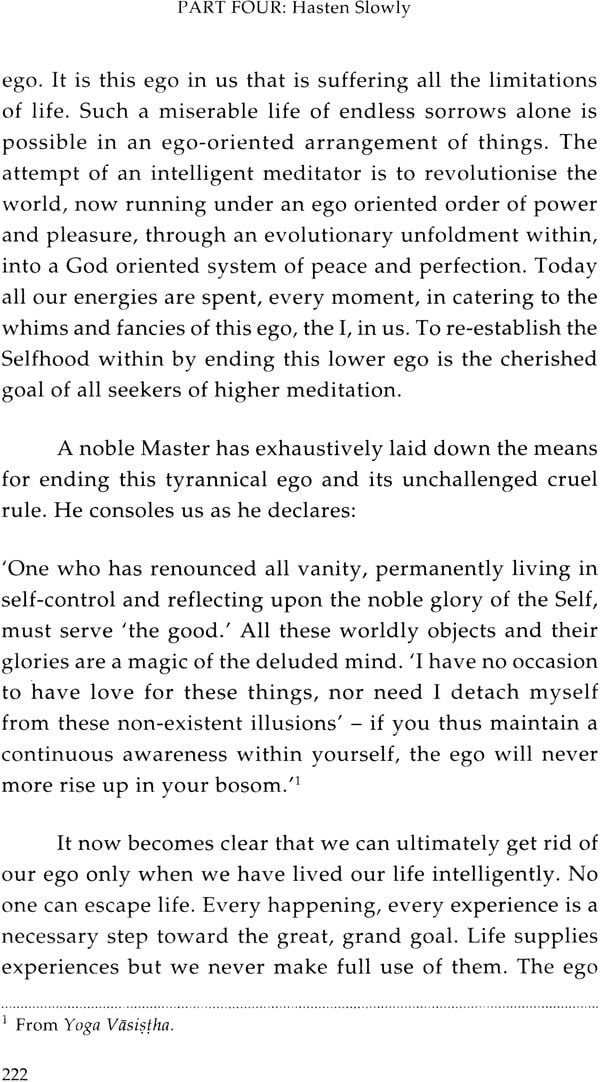
Meditation and Life (The Self-Discovery Series)
Book Specification
| Item Code: | IDG478 |
| Author: | Swami Chinmayananda Saraswati |
| Publisher: | CENTRAL CHINMAYA MISSION TRUST |
| Language: | English |
| Edition: | 2015 |
| ISBN: | 9788175976399 |
| Pages: | 220 |
| Cover: | Paperback |
| Other Details | 8.5" X 5.5" |
| Weight | 260 gm |
Book Description
From the Book:
As long as a person is alive, he or she comes into contact with different things and beings and circumstances. Nobody in the world can, even for a moment, live without coming into contact with the objects of the world outside, or at least with his or her own thoughts and ideas.
Thus, not by choice, but by the compelling law of life, every one of us must meet our world of circumstances at every moment of life. If we are efficient in meeting our own world-if we have ready dexterity, decisiveness, firm will, balance, equanimity, and right understanding-no situation in life can break or enslave us. But unfortunately many among us succumb to the apparent threats of life's situations and become shattered personalities.
A tragedy seems to be confronting much of the world today. Young people, their heads stuffed with facts and figures, go about in the world weighed down with sorrow and desperation. They try to run away from an inner sense of dejection by loudly proclaiming the glories of their age and of the civilization of their times. The organs of propaganda noisily howl the glories of the machine-age, the high standard of living, the efficiency of financial transactions, the nobility of governments, and the glories of war that uphold the blessings of peace!
Wherever you turn, from morning till night, you hear pedantic acclamations of the present age-through the radio, the press, through journals and books, on the screen, in theaters, on public platforms, in houses of parliament, at international conferences, and even from the pulpit. But, despite all these exaggerated glorifications, it is indeed a fact that every intelligent person with sensitive observation would readily conclude that there is obviously more unhappiness today than ever before. Unless one is blind, one cannot mistake the sorrows etched on the face of humanity in our times. The moment we take an honest look, we see desperation and tears.
I am not one of those who decry science and scientific inventions or the utility and efficiency of new methods of mechanical production or of modern systems of transport. Certainly science has discovered means and methods by which the drudgery of life has been almost lifted from our day-to-day existence. The necessities of life, even luxury goods, have been brought within the reach of the lower middle class.
As a social being, the individual has to a large extent been redeemed from the slaveries of barbarous ages. A sort of primary literacy has come to bless more than half of humanity. The barriers of tribes have been broken asunder, and even the walls of national patriotism have been at many points broken down in order to enhance international brotherhood and friendship.
The people of one region of the globe wander to another for education, earning their livelihood almost at the antipodes of their birthplace, and their last remains rest in peace in yet a different quarter of the world. Thus, many people have become natives of the globe, beyond the fold of caste and creed, national prestige, or the dignities of blood-groups.
Back of Book:
PHILOSOPHY/SELF HELP
We live in the outer world-but prompted from our own within, unless we master our inner lives, the outer scheme of life, however efficient and perfect, cannot but bring sorrow and unhappiness," says the author.
Swami Chinmayananda, one of the greatest exponents of Vedanta in modern times, takes us through the thought process necessary to gain control of our inner world. He first shows us the logic behind meditation and then teaches us the specific techniques for applying meditative practice to our daily lives. When meditation becomes a natural part of our day, we find our lives transformed and our minds at peace.
Preface:
Swami Chinmayananda
Many of us are overwhelmed by the complexity of our lives today. Because of that complexity, many seek to escape the pain and the pressure through a variety of means-through work or play or a combination of both. The tradition of spiritual thought called Vedanta advises us not to escape from life, but teaches us instead how to maintain a high quality of life through intelligent understanding of the true nature of existence.
In Meditation and Life, Swami Chinmayananda, one of the greatest teachers of Vedanta in modern times, takes us step by step through the thought process required to reestablish mastery over our lives, beginning with the world within. The instrument we use in our life experiences, says the author, is not the body, as we generally assume, but the mind. The state of our lives depends on the state of our mind. We all are familiar with the anguish we feel when our minds race uncontrollably around some worry, some experienced hurt, or some anticipated fear. Our minds manage to create a hell around us. As we learn to tame our minds into fit instruments of experience, step-by-step we gain control over our lives. No matter what our outer circumstances may be, with our minds controlled, we are the masters of the situation: we can choose to live in joy.
This is what meditation teaches us. Meditation and Life takes us through the logic behind meditation, as well as the specific techniques of applying meditative practice to our daily lives. Swami Chinmayananda shows us how, by gaining mastery over our inner lives, we transform our individual existence.
‘Our Physical , mental, intellectual and spiritual personalities must be blended into one harmonious whole. Meditation is the technique for achieving this harmony. It is the highest spiritual discipline. Through meditation we come to experience Pease within ourselves. Internecine wars between desire end. Conflicts between duties no longer torment us. The mind is able to view life as a whole’.
Many of us are overwhelmed by the complexity of our lives today. Because of that Complexity, many seek to escape the pain and the pressure through a variety of means, through work or play or a combination of both. The tradition of spiritual thought called Vedanta advises us not to escape from life but teaches us instead how to maintain a high quality of life through intelligent understanding of the true nature of existence.
In Meditation and Life, Swami Chinmayananda, one of the greatest teachers of Vedanta in modern times, takes us step by step through the thought process required to re-establish mastery over our lives, beginning with the world within. “The instrument we use in our life experiences” says the author” is not the body , as we generally assume, but the mind”. The state of our lives depends on the state of our mind. We all are familiar with the anguish we feel when our minds race uncontrollably around some worry, some experienced hurt or some anticipated fear- our minds manage to create a hell around us. As we learn to tame our minds into fit instruments of experience, step by step we gain control over our lives. No matter what our outer circumstances may be, with our minds controlled, we are the masters of the situation, we can choose to live in joy.
This is what meditation teaches us. Meditation and Life takes us through the logic behind meditation, as well as the specific techniques of applying meditative practice to our daily lives. Swami Chinmayananda shows us how by gaining mastery over our inner lives, we transform our individual existence.
| Publisher's Note | ||
| Preface | i | |
| Part One | ||
| The Need for Meditation | ||
| 1 | Self-Mastery | 1 |
| Despair amid Abundance | 1 | |
| The Cure for Mental Anguish | 6 | |
| 2 | Meditation and Life | 13 |
| 3 | The Basic Unit of Life | 17 |
| 4 | Spirit Enveloped in Matter | 22 |
| Our Multiple Personalities | 22 | |
| The Hydra-Headed Monster | 29 | |
| 5 | The Nature of Desire | 33 |
| Tracing the Course of One Desire | 34 | |
| World Perfection through Self- Perfecti | 38 | |
| 6 | Spiritual Growth | 41 |
| The Divine versus the Worldly Life | 42 | |
| The Technique of Self-Perfection | 47 | |
| 7 | How to Begin | 53 |
| Introspection and Self-Analysis | 54 | |
| Act Now | 58 | |
| 8 | Illusion and Reality | 63 |
| The Illusory World | 64 | |
| Inner War | 67 | |
| 9 | Character is the Man | 70 |
| Actions - Solidified Thoughts | 70 | |
| Making the Mind Pliable for Remouldir | 74 | |
| 10 | The Cross Body | 77 |
| 11 | The Subtle Body | 81 |
| 12 | Why Meditate? | 86 |
| Part Two | ||
| The Process of Meditation | ||
| 13 | Prepare for Meditation | 91 |
| Watch the Mind | 91 | |
| Develop a Devotional Attitude | 94 | |
| Posture | 95 | |
| Thought Massage | 96 | |
| Thought Parade | 98 | |
| 14 | Inquire, then Contemplate | 102 |
| 15 | Train the Mind | 106 |
| 16 | Japa Yoga | 110 |
| Procedure | 111 | |
| Mantras | 114 | |
| Cautions | 115 | |
| 17 | The Sacred Mantra Om | 119 |
| 18 | The Cayatrt Mantra | 126 |
| 19 | Silence the Mind | 133 |
| The Source of Actions | 133 | |
| Know the Enemy | 136 | |
| Transcend the Subtle Body | 139 | |
| 20 | The Positive Mind | 142 |
| 21 | Recharge the Mind | 145 |
| 23 | The Secret of Success | 152 |
| Inward Expansion | 156 | |
| Part Three | ||
| Aids to Meditation | ||
| 24 | A Review of Procedure | 161 |
| 25 | Hints for Taming the Mind | 164 |
| 26 | Keeping a Spiritual Diary | 173 |
| Part Four | ||
| Hasten Slowly | ||
| 27 | Progress Halting Ruts | 181 |
| 28 | Mental Dancings | 186 |
| 29 | The Subjective Conquest | 193 |
| 30 | The Present Moment | 197 |
| 31 | The Other Shore of Sarnsara | 202 |
| 32 | Study, Japa and Meditation | 206 |
| 33 | Inner Repose | 211 |
| 34 | Transforming Influences | 215 |
| 35 | Evolutionary Unfoldment | 220 |
| 36 | Consistent Efforts | 225 |
| 37 | Inner Silence | 230 |
| 38 | The Dawn of Wisdom | 234 |
| Appendix: | ||
| My Spiritual Diary | 241 | |
| Guide to Sanskrit Transliteration and Pronunciation | 245 | |
| Glossary | 247 |


